|
| When I was in the process of designing the re-waterproofing system about a decade ago to mitigate widespread leaks at the Powell Street BART Station, I found that the existing leaks were exacerbated by the 350o F steam pipe that lies between the ceiling of the station and the street above (ee http://www.tombutt.com/pdf/bart%20presentation.pdf ). I met with the owners at that time, NRG Energy Co. to get as much information as possible about the pipe and the surrounding construction.
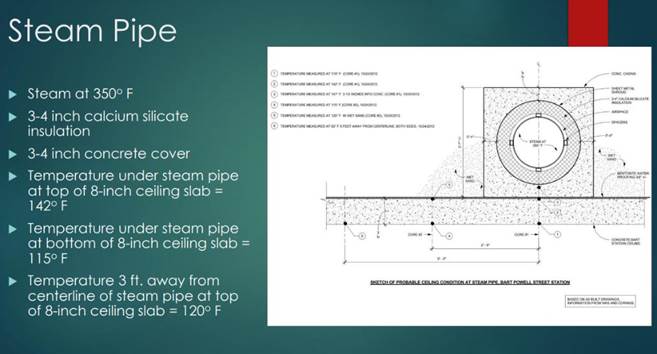
Figure 1 - Slide from PowerPoint Presentation on BART Powell Street Station Waterproofing Project
I also came to find out that there was an underground spring at the llower level of the Powell Street Station that produced tens of thousands oif gallons daily of clean spring water that was disposed of by pumping it into the sewer system. The win-win situation was obvious. I put NRG Energy Co. in touch with BART and the City of San Francisco to find a way that NRG could access the water and the City could avoid disposing of it ”down the drain,” so to speak. Cordia was formerly NRG Energy Co.
Apparemtly, it worked; the article below notes, “The broader San Francisco steam system, dating back to 1912, takes groundwater from beneath Powell BART Station.”
You’re welcome!
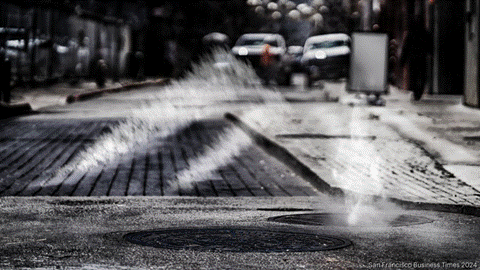
HOT STEAM, COLD CASH
The new owner of San Francisco's aging steam system envisions a carbon-free future rising from underground
expand
Steam rises from pipes owned by Cordia in San Francisco, which operates a steam heating network in the city.
ADAM PARDEE/SFBT
By Ted Andersen – Digital Editor, San Francisco Business Times
Jul 25, 2024
Updated Jul 25, 2024 3:00pm PDT
Listen to this article7 min
On a typically gray summer afternoon in San Francisco, steam leaks from a manhole on a cold, windswept street near City Hall.
More than just hot air, the ghostly vapor from the City Loop is a century-old vestige of the city’s industrial past — but one that’s being retooled for a 21st-century, clean-energy future. That work follows the sale in late spring of the two-square-mile network of underground steam pipes to an affiliate of Arizona-based Cordia, the private company that already operated the system, for just $1.
The knockdown price reflects the headaches that maintenance of the loop has presented to the city — and an internal estimate that as much as 60% to 70% of the piping needs to be replaced, according to the Office of the City Administrator. The city wanted to be out of the steam business; transferring ownership of what’s known in the business as a district energy system along with the operations, maintenance and liability shifted these costs to Cordia.
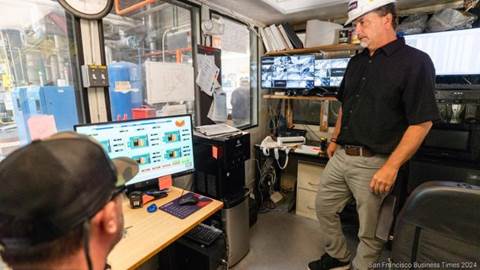
Michael Eurkus, general manager at Cordia Energy in San Francisco, sees a carbon-free future for the old steam system.
ADAM PARDEE
“Purchasing the steam without the added maintenance and operational costs is more cost-effective and efficient for the city,” said Angela Yip, senior communications and legislative analyst at the Office of the City Administrator. “Now we can purchase steam just like any other steam customer.”
The broader San Francisco steam system, dating back to 1912, takes groundwater from beneath Powell BART Station and pipes it for filtration and treatment before heating it at two boilers at 460 Jessie St. and 1 Meacham Pl. Within the City Loop, the piped steam provides heat to an assortment of mainly public buildings that include City Hall, Bill Graham Civic Auditorium, California State Court House, 101 Grove St., and the S.F. Department of Public Health.
Steam rises
The transfer creates new opportunities for Cordia, a venture formed in 2022. A predecessor company had managed and operated the city-owned portion on the city’s behalf since 1995. As of June, Cordia’s Energy Center San Francisco subsidiary officially assumed ownership and maintenance responsibility for the pipes.
Cordia General Manager Michael Eurkus said acquiring the steam infrastructure connects with its long-term plan of expanding its customer base in the city. Cordia is regulated by the California Public Utility Commission, and its customers — a mix of private owners of buildings and the city itself — pay it much like they do PG&E for electricity.
Cordia’s growth will be restrained by the physical limits of the steam system: The pipes it owns go north to Sacramento Street, south to Howard and east to Battery — but there is still room to expand its customer base, especially as the system’s full owner.
“In reality, we’re going after new buildings, existing buildings and then obviously moving forward buildings that want to go the carbon-free route,” Eurkus said. “Let’s just say there are buildings on the other side of the city that we may potentially get on to our system and we wouldn’t have been able to do that in the past because the piping wasn’t ours.”
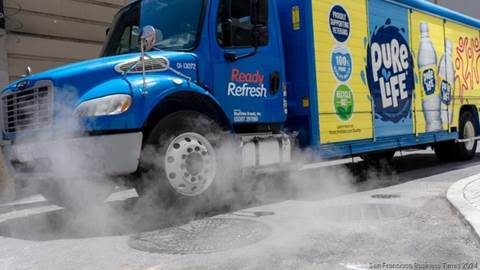
Steam rises out of the street as a truck passes by in downtown San Francisco. Steam can sometimes indicate a leak in the pipe network, which Cordia is repairing.
ADAM PARDEE
The push to unplug from natural gas is helping.
“Once (customers) come onto our system, you can eliminate gas from the building,” Eurkus said, adding that Cordia has already received a healthy level of inquiries from potential downtown energy customers. “And that’s kind of where we’re headed and that’s kind of why the city really was pushing this.”
The cost of connecting new buildings to the system — and who covers it — would depend on the details. Eurkus said Cordia could generally install pipes for free for a building that’s close to the existing system, if it wouldn’t be a huge lift to do a tie-in. But a customer whose building is, say, a block and a half off the system and would cost $1 million to excavate and run pipe would be asked to share the cost.
The biggest change the company is working towards, he added, is an agreement with the city to purchase power directly from the San Francisco Public Utilities Commission that comes off the Hetch Hetchy Dam.
“We’re going to build the infrastructure here and plan to convert our natural gas boilers into electric boilers and then use that carbon-free electricity to create carbon-free steam, which, if everything goes right and it does happen, will be the first district energy system in the country that can offer carbon-free steam,” he said.
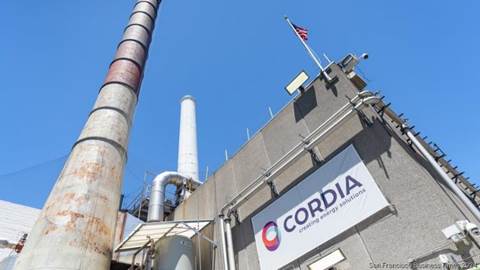
Exhaust stacks rise high over a Cordia Energy facility in San Francisco.
ADAM PARDEE
The city is also touting the potential benefits of its changed relationship with the company.
“We are pleased to work with Cordia in our shared goal of reducing carbon emissions and advancing sustainable energy solutions, while ensuring a reliable energy source for our buildings,” Andrico Penick, director of real estate for the city of San Francisco said in a statement. “This engagement represents a significant milestone in our efforts to create a greener, more resilient future for San Francisco.”
Going underground
But before it can do any of that, Cordia has to undertake a comprehensive, $3 million refurbishment of the City Loop, with plans to complete the project by the end of the year. Eurkus said Cordia in May excavated piping along the entire length of Polk Street in front of City Hall and began working on all the piping in there. It plans to finish that by Thanksgiving.
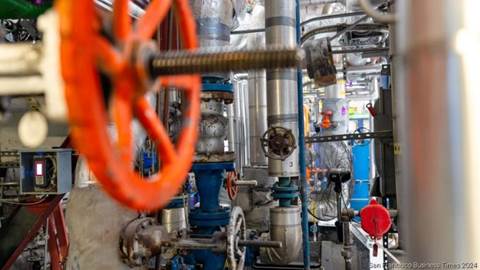
Cordia has two steam-generation facilities attached to the network of pipes.
ADAM PARDEE
“Part of us taking the system over was (the city) kind of waving the white flag saying, ‘We are really not in the steam maintenance/operation/repair business and you are, so let’s come to an agreement on how we can move forward with you guys taking this over,’” Eurkus said. “Quite honestly, for Cordia, we’ve always looked at it as more of a liability than as an asset because there’s a lot of work that has to be done out there.”
The more urgent parts of that work are already underway.
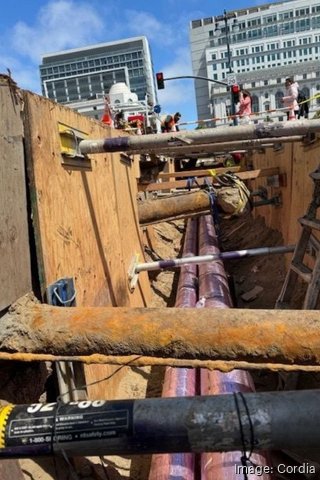
Cordia now controls a part of the system it didn't previously own, the San Francisco City Loop in Civic Center.
CORDIA
As Eurkus puts it, there’s good steam and bad steam. Vapor escaping from vault covers represent normal operation, but if it’s steam coming out of the ground, that signals a leak, and City Hall has had leaks for the better part of two years.
“That was the first thing that we took care of as soon as it was our property,” he said. “We didn’t want that liability anymore, so we fixed it.”
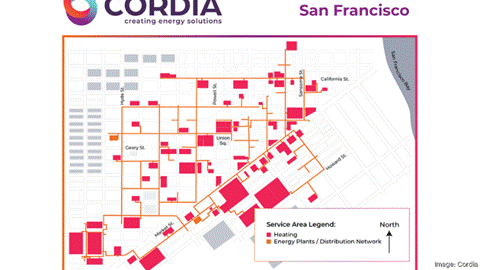
Cordia's district energy system in San Francisco.
CORDIA
Cordia, headquartered in Phoenix and owned by private equity giant KKR, has district energy systems peppered across the country, and last year, it expanded its footprint in Pittsburgh with a $165 million deal to acquire three energy grids there. The company officially launched in 2022 after Clearway Energy Inc. sold its Clearway Community Energy unit for $1.9 billion to KKR, which then renamed it Cordia.
Eurkus said Cordia is currently waiting on a system impact report from PG&E and that by the end of this year or potentially early next year, it will be in the permitting process. It’s now targeting late 2027 and early 2028 for the completion of the carbon-free transition.
In the meantime, there are boilers to keep running, pipes to fix and new customers to seek out. Steam is a century-old business in San Francisco — but in some ways, it’s just beginning to heat up.
|

